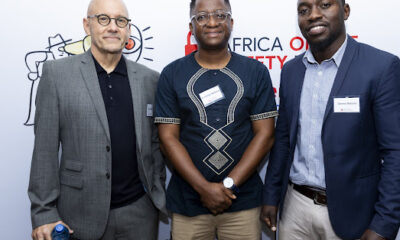The video, published to YouTube on Feb. 23, was awe-inspiring and scary. A two-legged humanoid robot trudges through the snow, somehow maintaining its balance. Another robot with two arms and pads for hands crouches down and lifts a brown box and delicately places it on a shelf — then somehow stays upright while a human tries to push it over with a hockey stick. A third robot topples over and clambers back to its feet with ease.
Tens of millions of people viewed the video over the next few weeks. Google and the division responsible for the video, Boston Dynamics, were seemingly pushing the frontier in robot technology.
But behind the scenes a more pedestrian drama was playing out. Executives at Google parent Alphabet Inc., absorbed with making sure all the various companies under its corporate umbrella have plans to generate real revenue, concluded that Boston Dynamics isn’t likely to produce a marketable product in the next few years and have put the unit up for sale, according to two people familiar with the company’s plans.
Possible acquirers include the Toyota Research Institute, a division of Toyota Motor Corp., and Amazon.com Inc., which makes robots for its fulfillment centers, according to one person. Google and Toyota declined to comment, and Amazon didn’t respond to requests for comment.
Robotics Push
Google acquired Boston Dynamics in late 2013 as part of a spree of acquisitions in the field of robotics. The deals were spearheaded by Andy Rubin, former chief of the Android division, and brought about 300 robotics engineers into Google. Rubin left the company in October 2014. Over the following year, the robot initiative, dubbed Replicant, was plagued by leadership changes, failures to collaborate between companies and an unsuccessful effort to recruit a new leader.
At the heart of Replicant’s trouble, said a person familiar with the group, was a reluctance by Boston Dynamics executives to work with Google’s other robot engineers in California and Tokyo and the unit’s failure to come up with products that could be released in the near term.
Tensions between Boston Dynamics and the rest of the Replicant group spilled into open view within Google, when written minutes of a Nov. 11 meeting and several subsequent e-mails were inadvertently published to an online forum that was accessible to other Google workers. These documents were made available to Bloomberg News by a Google employee who spotted them.
The November meeting was run by Jonathan Rosenberg, an adviser to Alphabet Chief Executive Officer Larry Page and former Google senior vice president, who was temporarily in charge of the Replicant group. In the meeting, Rosenberg said, “we as a startup of our size cannot spend 30-plus percent of our resources on things that take ten years,” and that “there’s some time frame that we need to be generating an amount of revenue that covers expenses and (that) needs to be a few years.”
‘Brick Wall’
Aaron Edsinger, director of robotics at Google in San Francisco, said that he had been trying to work with Boston Dynamics to create a low-cost electric quadruped robot and felt “a bit of a brick wall” around the division, according to the minutes of the meeting.
Marc Raibert, a former Massachusetts Institute of Technology professor and the founder of Boston Dynamics, said that “I firmly believe the only way to get to a product is through the work we are doing in Boston. (I) don’t think we are the pie in the sky guys as much as everyone thinks we are,” the minutes show.
Raibert didn’t respond to multiple messages seeking comment for this story.
Part of the challenge was that Alphabet, created in 2015, was geared toward making Google inviting to startup founders and entrepreneurial executives who wanted to join companies driving toward products and revenue, which could increase shareholder value for those subsidiaries. Page wanted to invite top-tier engineers to join the companies within Alphabet and entice them with equity.
In December, Google announced that Replicant had been folded into Google’s advanced research group, Google X. In a private all-hands meeting around that time, Astro Teller, the head of Google X, told Replicant employees that if robotics aren’t the practical solution to problems that Google was trying to solve, they would be reassigned to work on other things, according to a person who was at that meeting.
Distancing Google
Boston Dynamics, though, was never folded into Google X and was instead put up for sale. After the division’s latest robot video was posted to YouTube, in February, Google’s public-relations team expressed discomfort that Alphabet would be associated with a push into humanoid robotics. Their subsequent e-mails were also published to the internal online forum and became visible to all Google employees.
“There’s excitement from the tech press, but we’re also starting to see some negative threads about it being terrifying, ready to take humans’ jobs,” wrote Courtney Hohne, a director of communications at Google and the spokeswoman for Google X.
Hohne went on to ask her colleagues to “distance X from this video,” and wrote, “we don’t want to trigger a whole separate media cycle about where BD really is at Google.”
“We’re not going to comment on this video because there’s really not a lot we can add, and we don’t want to answer most of the Qs it triggers,” she wrote.
Bloomberg


 Billionaire Watch3 weeks ago
Billionaire Watch3 weeks ago
 Startups4 weeks ago
Startups4 weeks ago
 News4 weeks ago
News4 weeks ago
 News4 weeks ago
News4 weeks ago
 Bitcoin4 weeks ago
Bitcoin4 weeks ago
 Naira4 weeks ago
Naira4 weeks ago
 Forex3 weeks ago
Forex3 weeks ago
 Treasury Bills4 weeks ago
Treasury Bills4 weeks ago






















